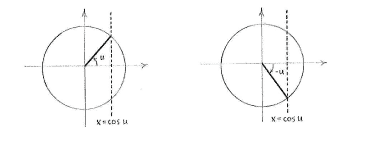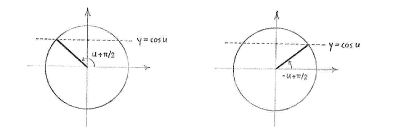Solution 4.4:7c
From Förberedande kurs i matematik 1
If we want to solve the equation \displaystyle \cos 3x = \sin 4x, we need an additional result which tells us for which values of u and v the equality \displaystyle \cos u = \sin v holds, but to get that we have to start with the equality \displaystyle \cos u=\cos v.
So, we start by looking at the equality
| \displaystyle \cos u=\cos v\,\textrm{.} |
We know that for fixed u there are two angles \displaystyle v=u and \displaystyle v=-u in the unit circle which have the cosine value \displaystyle \cos u, i.e. their x-coordinate is equal to \displaystyle \cos u\,.
Imagine now that the whole unit circle is rotated anti-clockwise an angle \displaystyle \pi/2. The line \displaystyle x=\cos u will become the line \displaystyle y=\cos u and the angles u and -u are rotated to \displaystyle u+\pi/2 and \displaystyle -u+\pi/2, respectively.
The angles \displaystyle u+\pi/2 and \displaystyle -u+\pi/2 therefore have their y-coordinate, and hence sine value, equal to \displaystyle \cos u. In other words, the equality
| \displaystyle \cos u = \sin v |
holds for fixed u in the unit circle when \displaystyle v = \pm u + \pi/2, and more generally when
| \displaystyle v = \pm u + \frac{\pi}{2} + 2n\pi\qquad(n is an arbitrary integer). |
For our equation \displaystyle \cos 3x = \sin 4x, this result means that x must satisfy
| \displaystyle 4x = \pm 3x + \frac{\pi}{2} + 2n\pi\,\textrm{.} |
This means that the solutions to the equation are
| \displaystyle \left\{\begin{align}
x &= \frac{\pi}{2} + 2n\pi\,,\\[5pt] x &= \frac{\pi}{14} + \frac{2}{7}\pi n\,, \end{align}\right. |
where n is an arbitrary integer.


